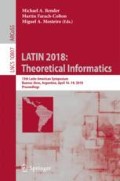Abstract
Consider a graph \(G=(V,E)\) and an initial random coloring where each vertex \(v \in V\) is blue with probability \(P_b\) and red otherwise, independently from all other vertices. In each round, all vertices simultaneously switch their color to the most frequent color in their neighborhood and in case of a tie, a vertex keeps its current color. The main goal of the present paper is to analyze the behavior of this basic and natural process on the random d-regular graph \(\mathbb {G}_{n,d}\). It is shown that for \(\epsilon >0\), \(P_b \le 1/2-\epsilon \) results in final complete occupancy by red in \(\mathcal {O}(\log _d\log n)\) rounds with high probability, provided that \(d\ge c/\epsilon ^2\) for a sufficiently large constant c. We argue that the bound \(\mathcal {O}(\log _d\log n)\) is asymptomatically tight. Furthermore, we show that with high probability, \(\mathbb {G}_{n,d}\) is immune; i.e., the smallest dynamic monopoly is of linear size. A dynamic monopoly is a subset of vertices that can “take over” in the sense that a commonly chosen initial color eventually spreads throughout the whole graph, irrespective of the colors of other vertices. This answers an open question of Peleg [22].
Access this chapter
Tax calculation will be finalised at checkout
Purchases are for personal use only
Notes
- 1.
For an n-node graph \(G=(V,E)\), we say an event happens with high probability (w.h.p.) if its probability is at least \(1-o(1)\) as a function of n. Notice we do not require the probability \(1-1/n^c\), for a constant \(c>0\), as it is done in some contexts.
- 2.
For a more formal description of the construction, please see [7], and notice since the second element always is chosen randomly, the generated configuration is random.
References
Aizenman, M., Lebowitz, J.L.: Metastability effects in bootstrap percolation. J. Phys. A: Math. Gen. 21(19), 3801 (1988)
Amini, H., Draief, M., Lelarge, M.: Flooding in weighted sparse random graphs. SIAM J. Discrete Math. 27(1), 1–26 (2013)
Balogh, J., Bollobás, B., Morris, R.: Majority bootstrap percolation on the hypercube. Comb. Probab. Comput. 18(1–2), 17–51 (2009)
Balogh, J., Pittel, B.G.: Bootstrap percolation on the random regular graph. Random Struct. Algorithms 30(1–2), 257–286 (2007)
Bender, E.A., Canfield, E.R.: The asymptotic number of labeled graphs with given degree sequences. J. Comb. Theory Ser. A 24(3), 296–307 (1978)
Berger, E.: Dynamic monopolies of constant size. J. Comb. Theory Ser. B 83(2), 191–200 (2001)
Bollobás, B., Fernandez de la Vega, W.: The diameter of random regular graphs. Combinatorica 2(2), 125–134 (1982)
de Oliveira, M.J.: Isotropic majority-vote model on a square lattice. J. Stat. Phys. 66(1), 273–281 (1992)
Feller, W.: An Introduction to Probability Theory and Its Applications: Volume I, vol. 3. Wiley, New York (1968)
Flocchini, P., Lodi, E., Luccio, F., Pagli, L., Santoro, N.: Dynamic monopolies in tori. Discrete Appl. Math. 137(2), 197–212 (2004)
Fountoulakis, N., Panagiotou, K.: Rumor spreading on random regular graphs and expanders. In: Serna, M., Shaltiel, R., Jansen, K., Rolim, J. (eds.) APPROX/RANDOM-2010. LNCS, vol. 6302, pp. 560–573. Springer, Heidelberg (2010). https://doi.org/10.1007/978-3-642-15369-3_42
Frischknecht, S., Keller, B., Wattenhofer, R.: Convergence in (social) influence networks. In: Afek, Y. (ed.) DISC 2013. LNCS, vol. 8205, pp. 433–446. Springer, Heidelberg (2013). https://doi.org/10.1007/978-3-642-41527-2_30
Gärtner, B., Zehmakan, A.N.: (Biased) majority rule cellular automata. arXiv preprint arXiv:1711.10920 (2017)
Gärtner, B., Zehmakan, A.N.: Color war: cellular automata with majority-rule. In: Drewes, F., Martín-Vide, C., Truthe, B. (eds.) LATA 2017. LNCS, vol. 10168, pp. 393–404. Springer, Cham (2017). https://doi.org/10.1007/978-3-319-53733-7_29
Goles, E., Olivos, J.: Comportement périodique des fonctions à seuil binaires et applications. Discrete Appl. Math. 3(2), 93–105 (1981)
Janson, S., Luczak, T., Rucinski, A.: Random Graphs, vol. 45. Wiley, Hoboken (2011)
Kaaser, D., Mallmann-Trenn, F., Natale, E.: On the voting time of the deterministic majority process. arXiv preprint arXiv:1508.03519 (2015)
Kempe, D., Kleinberg, J., Tardos, É.: Maximizing the spread of influence through a social network. In: Proceedings of the Ninth ACM SIGKDD International Conference on Knowledge Discovery and Data Mining, pp. 137–146. ACM (2003)
Land, M., Belew, R.K.: No perfect two-state cellular automata for density classification exists. Phys. Rev. Lett. 74(25), 5148 (1995)
Mourrat, J.-C., Valesin, D., et al.: Phase transition of the contact process on random regular graphs. Electron. J. Probab. 21 (2016)
Peleg, D.: Local majority voting, small coalitions and controlling monopolies in graphs: a review. In: Proceedings of 3rd Colloquium on Structural Information and Communication Complexity, pp. 152–169 (1997)
Peleg, D.: Immunity against local influence. In: Dershowitz, N., Nissan, E. (eds.) Language, Culture, Computation. Computing - Theory and Technology. LNCS, vol. 8001, pp. 168–179. Springer, Heidelberg (2014). https://doi.org/10.1007/978-3-642-45321-2_8
Poljak, S., Turzík, D.: On pre-periods of discrete influence systems. Discrete Appl. Math. 13(1), 33–39 (1986)
Schonmann, R.H.: Finite size scaling behavior of a biased majority rule cellular automaton. Phys. A: Stat. Mech. Appl. 167(3), 619–627 (1990)
Spitzer, F.: Interaction of Markov processes. Adv. Math. 5(2), 246–290 (1970)
Stefánsson, S.Ö., Vallier, T.: Majority bootstrap percolation on the random graph G(n, p). arXiv preprint arXiv:1503.07029 (2015)
Acknowledgments
The authors would like to thank Mohsen Ghaffari for several stimulating conversations and Jozsef Balogh and Nick Wormald for referring to some relevant prior results.
Author information
Authors and Affiliations
Corresponding author
Editor information
Editors and Affiliations
Rights and permissions
Copyright information
© 2018 Springer International Publishing AG, part of Springer Nature
About this paper
Cite this paper
Gärtner, B., Zehmakan, A.N. (2018). Majority Model on Random Regular Graphs. In: Bender, M., Farach-Colton, M., Mosteiro, M. (eds) LATIN 2018: Theoretical Informatics. LATIN 2018. Lecture Notes in Computer Science(), vol 10807. Springer, Cham. https://doi.org/10.1007/978-3-319-77404-6_42
Download citation
DOI: https://doi.org/10.1007/978-3-319-77404-6_42
Published:
Publisher Name: Springer, Cham
Print ISBN: 978-3-319-77403-9
Online ISBN: 978-3-319-77404-6
eBook Packages: Computer ScienceComputer Science (R0)

